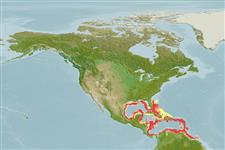>
Lophiiformes (Anglerfishes) >
Lophiidae (Goosefishes)
Etymology: Lophiodes: Greek, lophos = crest + Greek, suffix oides = similar to (Ref. 45335).
Environment: milieu / climate zone / depth range / distribution range
Ökologie
seewasser bathydemersal; tiefenbereich 64 - 820 m (Ref. 13608). Deep-water; 12°C - 19°C (Ref. 1964); 30°N - 7°N
Western Atlantic: between 29°57'N and 7°18'N. Southern Florida (USA), Gulf of Mexico, Puerto Rico, western and southern Caribbean, Lesser Antilles to northern coast of South America (Ref. 26938).
Size / Gewicht / Alter
Maturity: Lm ? range ? - ? cm
Max length : 25.0 cm TL Männchen/unbestimmt; (Ref. 5217); common length : 15.0 cm TL Männchen/unbestimmt; (Ref. 5217)
Kurzbeschreibung
Morphologie | Morphometrie
Rückenflossenstacheln (insgesamt): 6; Rückenflossenweichstrahlen (insgesamt): 8; Afterflossenstacheln 0; Afterflossenweichstrahlen: 6 - 8. Esca with pennant-like flap, long cirri, and usually with dark stalked eye-like appendages; dorsal surface of head, body and pectoral fins with distinct reticular pattern; ventral surface light tan to white; ventral surface of pelvic fin darker distally (Ref. 13608).
Found in continental shelf waters. A voracious carnivore. (Ref. 26938).
Life cycle and mating behavior
Geschlechtsreife | Fortpflanzung | Ablaichen | Eier | Fecundity | Larven
Caruso, J.H., 1981. The systematics and distribution of the lophiid anglerfishes. I. A revision of the genus Lophiodes with the description of two new species. Copeia 1981(3):522-549. (Ref. 5263)
IUCN Rote Liste Status (Ref. 130435)
Bedrohung für Menschen
Harmless
Nutzung durch Menschen
Mehr Information
NamenSynonymeMetabolismusRäuberÖkotoxikologieFortpflanzungGeschlechtsreifeAblaichenSpawning aggregationFecundityEierEientwicklung
Alter/GrößeWachstumLänge-GewichtLänge-LängeLängenhäufigkeitenMorphometrieMorphologieLarvenLarven Pop.Dyn.RekrutierungDichteBRUVS
ReferenzenAquakulturAquakultur ProfilZuchtlinienGenetikElectrophoresesVererbbarkeitKrankheitenVerarbeitungNutrientsMass conversion
PartnerBilderStamps, Coins Misc.LauteCiguateraGeschwindigkeitSchwimmstilKiemenoberflächeOtolithsGehirngrößeSehfähigkeit
Tools
Zusatzinformationen
Download XML
Internet Quellen
Estimates based on models
Preferred temperature (Ref.
123201): 10.3 - 21.5, mean 15.7 °C (based on 107 cells).
Phylogenetic diversity index (Ref.
82804): PD
50 = 0.5000 [Uniqueness, from 0.5 = low to 2.0 = high].
Bayesian length-weight: a=0.01995 (0.00918 - 0.04336), b=3.00 (2.81 - 3.19), in cm total length, based on LWR estimates for this (Sub)family-body shape (Ref.
93245).
Trophic level (Ref.
69278): 4.2 ±0.7 se; based on size and trophs of closest relatives
Widerstandsfähigkeit (Ref.
120179): hoch, Verdopplung der Population dauert weniger als 15 Monate. (Preliminary K or Fecundity.).
Fishing Vulnerability (Ref.
59153): Low vulnerability (15 of 100).
